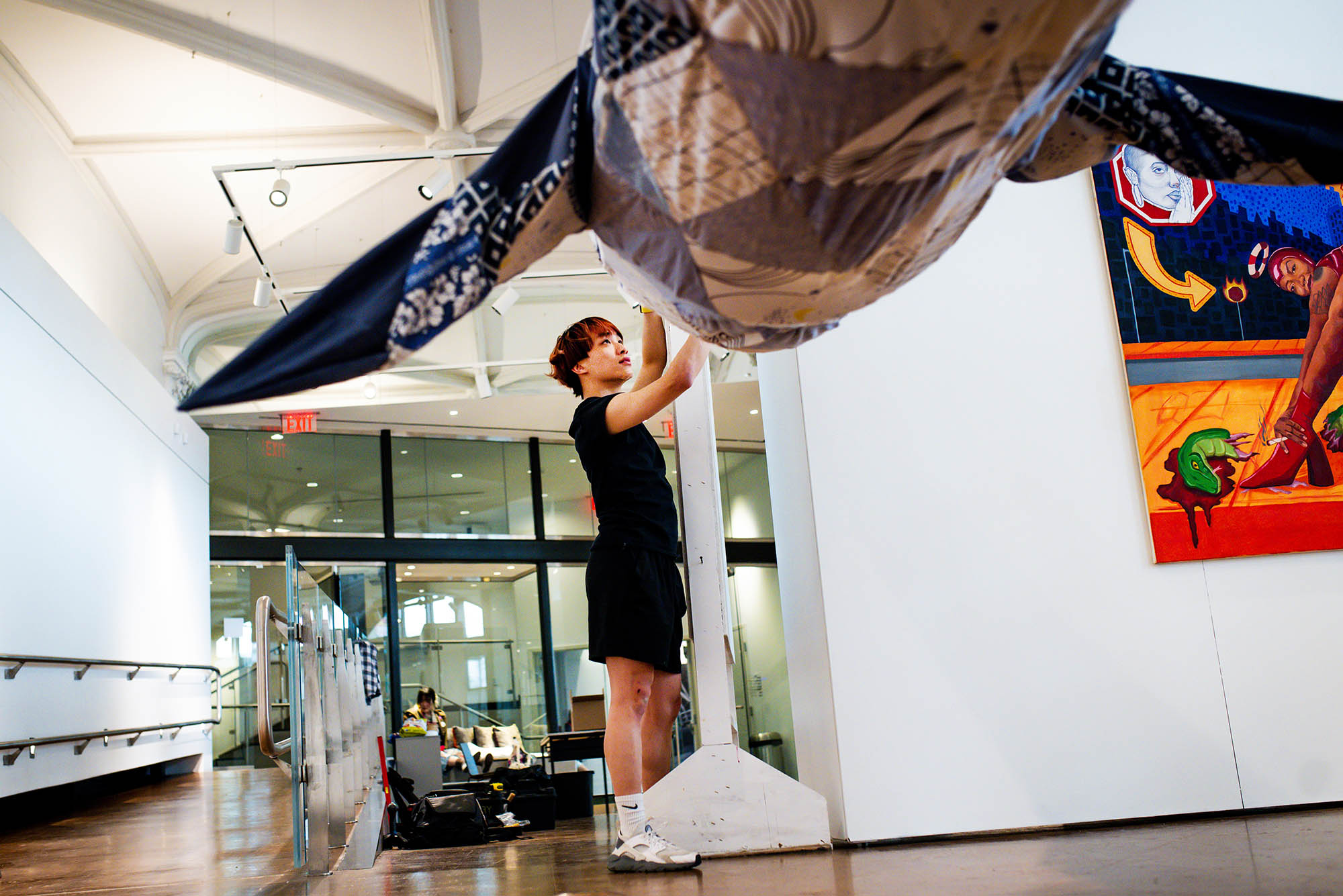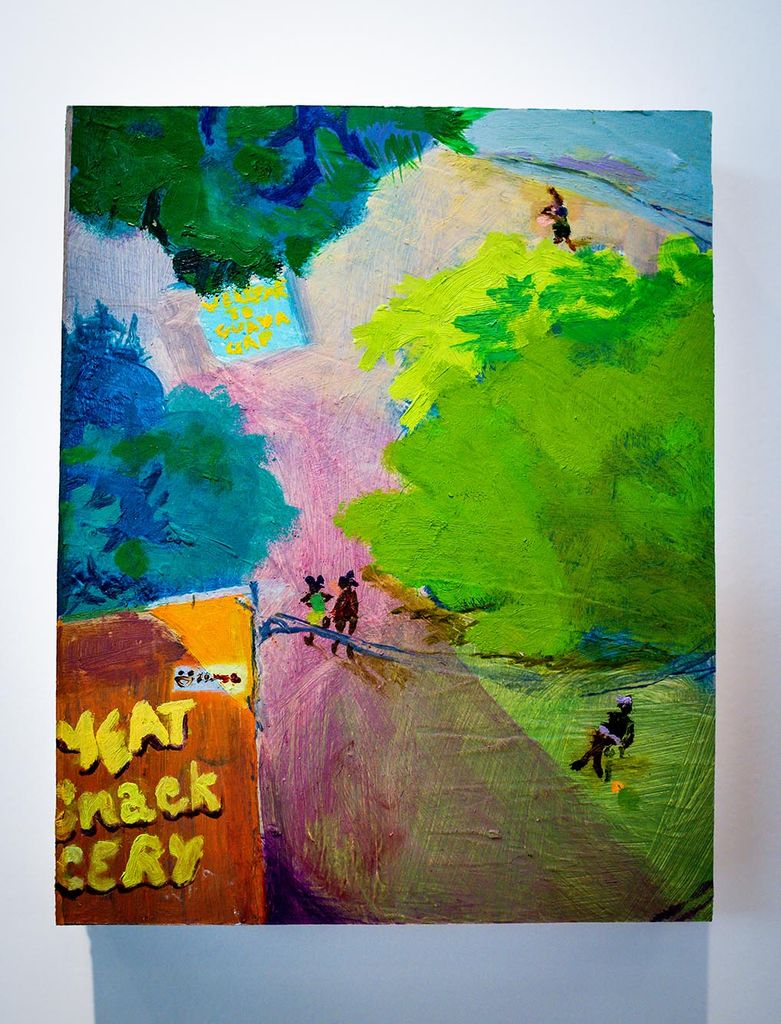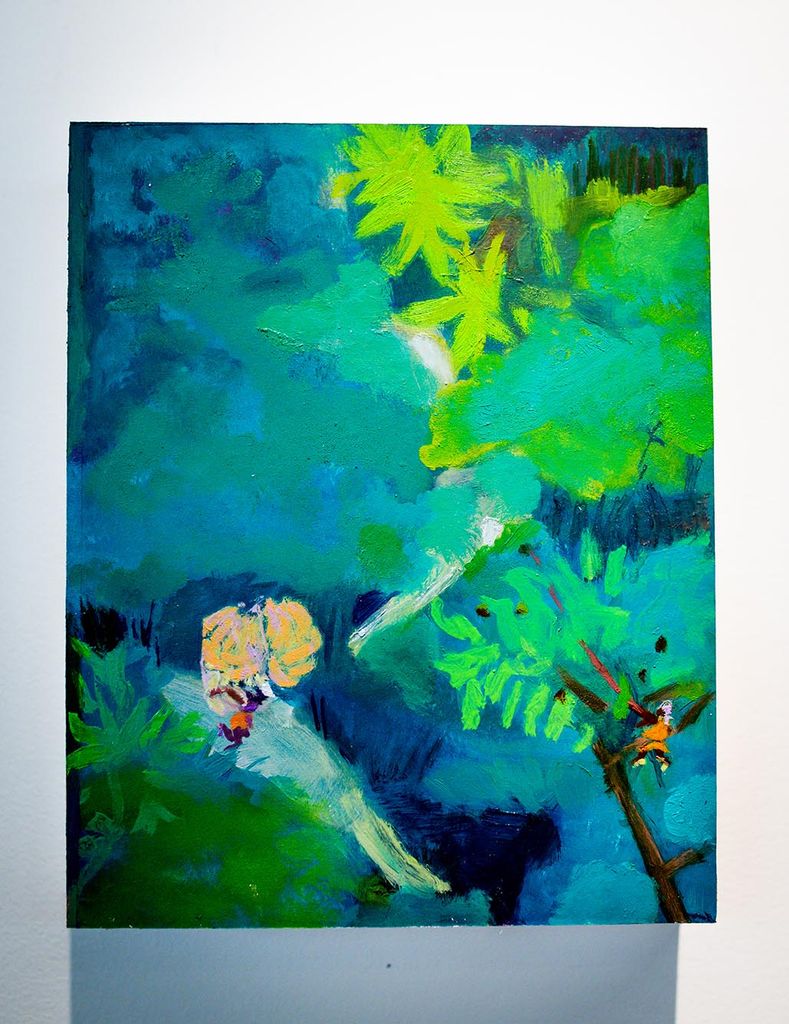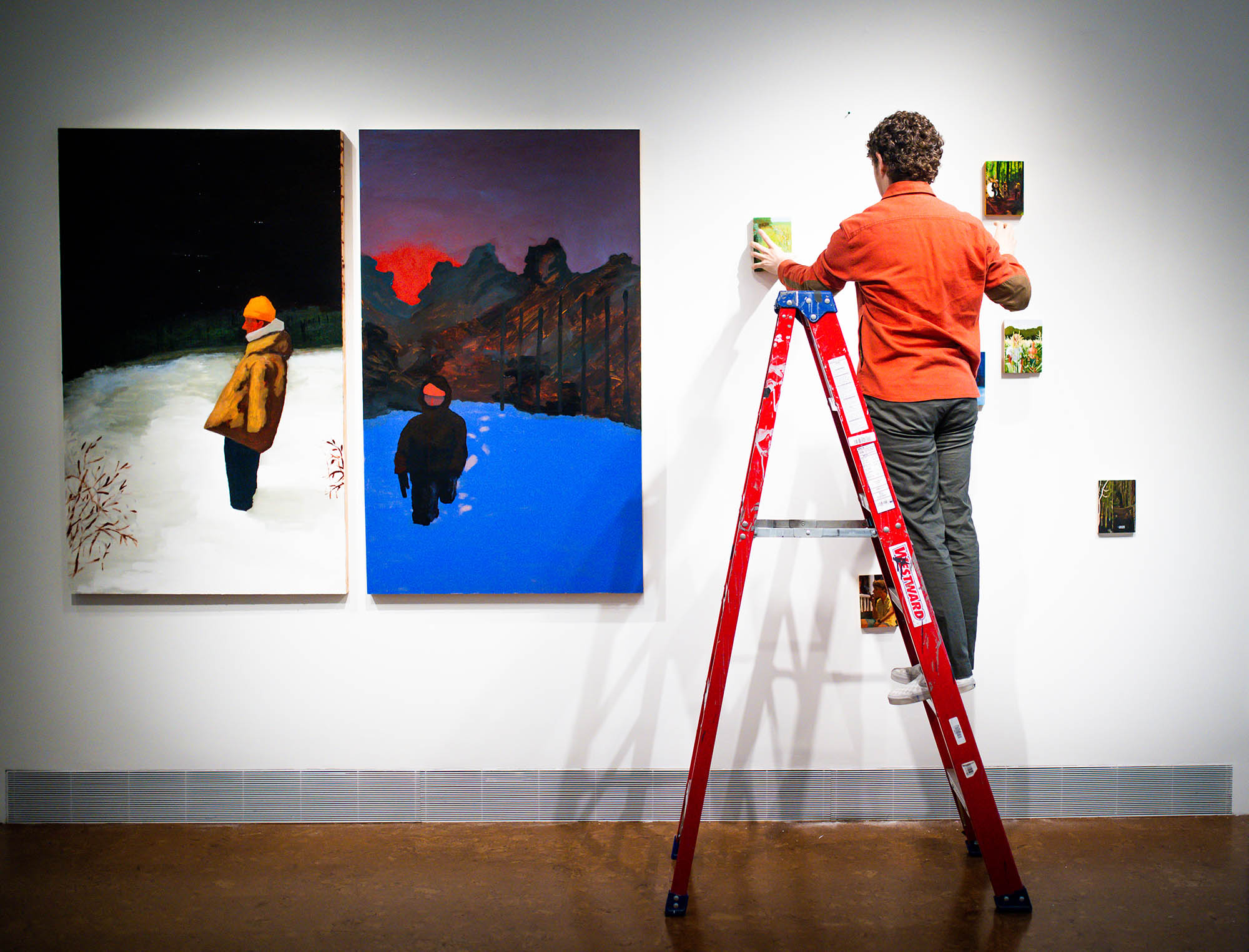Works by BFA Painting, Sculpture, Printmaking Graduates Now on View at Stone Gallery
Show includes paintings, silk etchings, and a 20-foot whale sculpture

Felix Huang (CFA’23), the only graduating sculpture major in the 2023 Painting, Sculpture, and Printmaking Thesis Exhibition, installs his 20-foot “Guardian Whale” in the Faye G., Jo, and James Stone Gallery ahead of the show’s opening day on May 9. The exhibition is on view through May 19.
Works by BFA Painting, Sculpture, Printmaking Graduates Now on View at Stone Gallery
Show includes paintings, silk etchings, and a 20-foot whale sculpture
Felix Huang, a graduating senior in the College of Fine Arts School of Visual Arts sculpture program, is in the midst of figuring out how to install a 20-foot whale sculpture in the Faye G., Jo, and James Stone Gallery. He is surrounded by fellow seniors in SVA’s painting, sculpture, and printmaking programs, all of whom are busy installing their own work ahead of the opening of the 2023 BFA Thesis Exhibition, on view now through May 19. The gallery is awash with movement and the sound of drills, all dedicated to assembling the 47 artworks to be featured in the show. Though the media ranges from the traditional—oil, acrylic, gouache, ceramic—to the more novel—woodwork, cyanotype, collagraph, silk etching—none tops Huang’s magnum opus in terms of sheer size.
“It shows off my ability, capability, and work ethic to create large-scale works,” Huang (CFA’23) says of his ambitious “Guardian Whale,” which he constructed from bedsheets, curtains, and bamboo. “I should let my work speak for itself, but this whale displays my appreciation of this animal as beautiful and spiritual.”
This year, BFA graduates in the graphic design and painting, sculpture, and printmaking programs are exhibiting their thesis work in two concurrent exhibitions. The graphic design show is on view at the 808 Gallery at 808 Comm Ave. (Check out our coverage of that show later this week). While School of Visual Arts students typically work with multiple forms during their time at CFA, the onset of thesis season means a sharp narrowing of focus, which is why Huang, the only sculpture major among this year’s 20 graduating seniors, spent the majority of his spring semester creating a whale.
“I spent a lot of time in class and in the studio alone,” he says. “The time that I was working alone, it was peaceful and I felt like I was in my own world. From that, I feel like I became self reliant.”
In the video above, Bonnie Yu (CFA’23), a senior majoring in painting and printmaking, talks about how each form influences the other in her work and shares the inspiration for her BFA Thesis project.
Cathy Della Lucia, a CFA lecturer in the sculpture program, says the SVA curriculum is designed to give students a foundational knowledge of various media, while in later years they receive a more focused education in their major area. In their final semesters, students take studio courses structured around their individual practices and research interests.
“It has been wonderful to see [the students] become more confident in their decision making,” Della Lucia (CFA’17) says. “There are endless decisions to be made every day in their studios—scale, material, surface, installation, color, et cetera—and their year of self-guided research, hard work, and resilience has truly honed their unique voices that are both intentional and honest to their experiences.”
In preparation for their final exhibition, students also develop a written thesis and conduct 10-minute studio visits with curator Leah Triplett Harrington, whose challenge is to cohere an assortment of artistic visions.
“This show is a critical part of how the students learn to collaborate–with each other, their professors, and me, an outside independent curator,” Triplett Harrington says. “I love seeing the students support each other–from developing their works to thinking through display strategies to installing their works together.”
Triplett Harrington, a Boston-based writer, editor, and curator now in her third year partnering on the BFA senior thesis exhibitions, found that the artists she worked with were “very engaged with changing the narratives that formulate our familiar” by using their work to challenge norms. Bonnie Yu, one of this year’s three graduating printmakers, uses her practice to expose a history of unjust treatment toward women in China, where she grew up. Yu represents motifs of subjugation, such as footbinding and domestic isolation, in her etchings on silk, displayed on traditional wooden cloth-hanging racks that she constructed for the exhibition.
“In one of my etchings, ‘The Housekeeper,’ the woman’s face is obscured but everything else is easy to see,” Yu (CFA’23, CAS’23) says. “This represents the injustice of female isolation in China, where women were expected to stay home and not engage with the world and were physically trapped at home because of their bound feet.”
Yu, who is double majoring in painting and printmaking at CFA, notes that etching is a Western art form, but the materials she uses and the figures she depicts are unmistakably Chinese.
“I have an unorthodox approach to etching inspired by traditional Chinese clothing, hanfu,” Yu says. Hanfu, often referred to as the national garment of China, has been worn for over three millennia. “The beauty of the clothing serves as an entry point for the viewer’s eyes and leads the viewer into my story.”


Paintings by Asjha Malcolm (CFA’23), “Welcome to Guava Gap” and “The Sun and Her Children (small),” hang side by side in the Stone Gallery.
Asjha Malcolm (CFA’23), one of 16 graduating painters, also devotes her practice to subverting common racial narratives. She uses oil on canvas to depict Black subjects from a bird’s-eye view amid a blur of nature—some of her figures run through dirt roads edged with tropical plants; others are surrounded by a forest amid riotous slashes of green. The scenes are too dreamlike, the figures too distant, to assign much specificity: Are they working or resting, joyful or grieving?
“Because of the mundanity being depicted through the lens of Black experience, my work may be reacting to a larger societal conversation of what “Black” art is and the preconceived notions that come with that art, historically,” Malcolm says. “I would like to subvert ideas of “Black” art, because there is no monolithic example of what Black art should look like—but also affirm and celebrate that I get to add to the already diverse and substantial Black art canon.”
Fox Hysen, a CFA lecturer in painting, worked with Malcolm and the 19 other painting seniors as they prepared their senior theses. Hysen says the most satisfying part of the annual process is watching students become comfortable enough to probe at deeper, more vulnerable aspects of their practices.
“In my experience, the best art emerges when a group can feel safe and take risks around each other,” he says.

Alessandro LoPresti’s oil paintings share the memory-laced liminality of Malcolm’s work, but their cast is more surreal, almost sinister. Figures hide in plain sight, confronting the viewer from behind a stalk of corn or in the dark just beyond a treeline, eyes glowing. LoPresti says his practice is somatic, almost subconscious, in which the aesthetics of the scene trump the figuration.
“I usually choose what becomes an image based on what the elements [a photo or a memory] will allow me to work with: That shadow could be so green, the sky looked like cement, things like that,” LoPresti says. “There is maybe some more innate selection process going on subconsciously, but that’s not for me to understand right now.”
During LoPresti’s 10-minute studio visit with Triplett Harrington, the two discussed his practice and the challenges he was facing while they selected pieces for the show. They chose two multi-panel pieces, taking into account the breadth of LoPresti’s work and how it would best fit the gallery space. Triplett Harrington says she took her layout cues directly from the students, as well as how the artworks would communicate with one another in a shared space. In a show of such breadth and abundance–20-foot whales notwithstanding–collaboration had to rule the day.
“We have a very diverse range of painters, sculptors, and printmakers in this class, in all aspects of artmaking,” LoPresti says. “We have some extremely smart and driven people, and I really do feel a lot of love in the group as well. I’m jittery to see what everyone is going to be doing once we all disperse.”
The BFA Painting, Sculpture, and Printmaking Thesis Exhibition is at the Faye G., Jo, and James Stone Gallery, 855 Commonwealth Ave., and the BFA Graphic Design Thesis Exhibition is at the 808 Gallery, 808 Commonwealth Ave., through Friday, May 19. Hours: Tuesday to Saturday, 11 am to 5 pm. The exhibitions are free and open to the public.
Comments & Discussion
Boston University moderates comments to facilitate an informed, substantive, civil conversation. Abusive, profane, self-promotional, misleading, incoherent or off-topic comments will be rejected. Moderators are staffed during regular business hours (EST) and can only accept comments written in English. Statistics or facts must include a citation or a link to the citation.